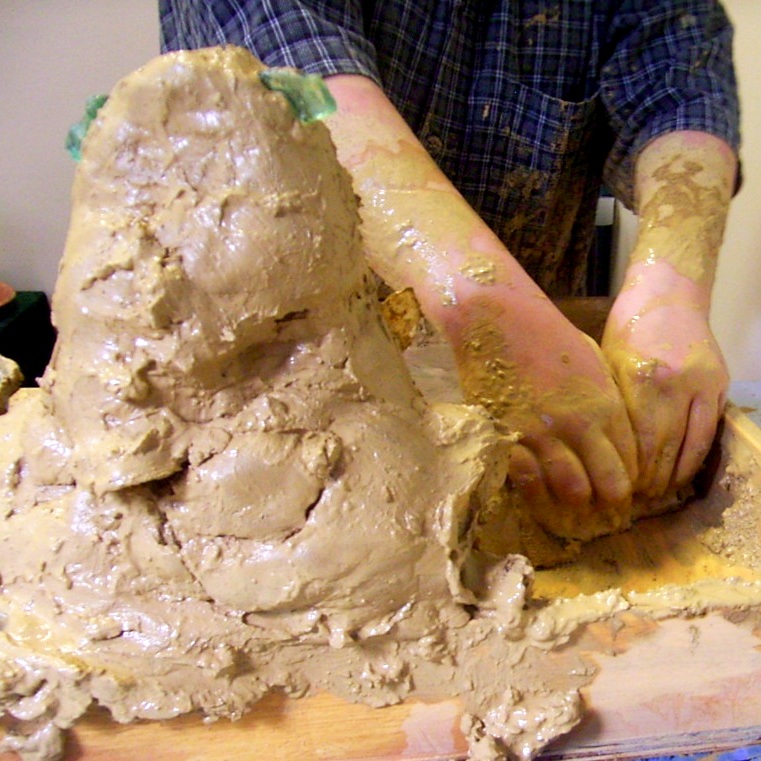Clay Field Therapy: Work at the Clay Field®
Work at the Clay Field
The Clay Field is a flat rectangular wooden box that holds 10 – 15 kg of clay. A bowl of water is supplied. This simple setting offers a symbolic “world” for the hands to explore. There will be no art work to be taken home. The hands enter the Clay Field and move in it; in their ability or inability to “handle” the material they tell the client's life story. The hands then can be encouraged to find ways to deal with situations and events, to complete actions that previously could not be coped with.
This unique art therapy approach is recognized in Europe as a discipline in its own right. Over 500 Clay Field Therapists are currently practicing in numerous institutions. It is part of the curriculum in schools for disabled and disadvantaged children; it is widely used in women's shelters, refugee centres and to facilitate trauma healing.
“Due to the texture, weight and resistance of the clay, the material demands physical effort. Very quickly the head – and with it our cognitive conditioning – is pushed aside to make way for the more “ancient” urges of our libido.
There will be no finished product, no artwork to show to friends, no sculpture to be fired in a kiln. At the end of a Clay Field session, only intense body memories will be taken home. The kinaesthetic motor action combined with sensory perception will have lasting therapeutic benefits, especially in cases of developmental delays in children and trauma healing.
Touch is the most fundamental of human experiences. The first year of our life is dominated by the sense of touch. Tactile contact is the first mode of communication we learn. Our earliest stages in life are dominated by oral and skin contact between infant and caregiver. Our earliest body memories and our core attachments were formed when we relied on sensorimotor feedback to feel safe and loved. Love as well as violence is primarily communicated through touch. Our boundaries are invaded through inappropriate touching. Sexual experiences are overwhelmingly ruled by the sense of touch – and so are medical procedures, as well as all other events that happened to our bodies.
Work at the Clay Field involves an intense tactile experience – it can link us to a primordial mode of communication, to a preverbal stage in our life. This is the truly beneficial quality of clay in a therapeutic context. Its regressive qualities will allow a therapist to address early attachment issues, developmental setbacks and traumatic events in a primarily non-verbal way, contained in the safety of the setting.
Toddlers may pile simple building blocks on top of each other and then enjoy knocking them down over and over again, thus learning creative destruction as a way to achieve object constancy (Winnicott 1971). Such play prepares children to cope with the real world as a continuum of constant change, of encounter and separation, of comings and goings of loved ones and events, of endings and beginnings. Trust is gained from the ability to survive such changes intact. Work at the Clay Field involves a continuous process of destruction and creation, because the material is both limited in its amount and unlimited in its possibilities. We can create at the Clay Field only if we dare to destroy the smooth surface and continue to have the courage to take something apart that we have put together before. We can learn to survive change; to grasp and handle it. In this manner the work can assist in dealing with the emotional injuries we suffered from overwhelming change and destruction in the past.
Pre-school children learn primarily through touching and handling objects. During the evolution of mankind, the cognitive brain was shaped through skilled hand movements; with our hands we learned to understand the world (Wilson 1999). These innate language skills become reactivated through handling things and through observing the hand-gestures of our caregivers, as a recent study at the University of Chicago showed (Rowe 2005; 2008).
School children will create three-dimensional representations in the clay – ‘real objects’, figures, scenes and landscapes that have meaning and emotional values attached to them. At the Clay Field adults and children alike weave these developmental layers into a complex web of biography, formative kinaesthetic body memories, frustrated or traumatized internalized patterns of behaviour and the search for more authentic impulses and holistic structures.”
From C. Elbrecht, Trauma Healing at the Clay Field 2012
Work at the Clay Field
In recent years “sensorimotor” has emerged as a term to describe body focused psychotherapies that use a bottom-up approach. Instead of a cognitive top-down strategy, sensorimotor art therapy encourages the awareness of innate motor impulses in the muscles and viscera, also as heart-rate and breath. The expression of these motor impulses followed by their perception through the senses, allows the development of new neurological pathways that can bypass traumatic memories; such an approach is capable of restoring wholeness and wellbeing.
Work at the Clay Field is a sensorimotor, body-focused, trauma-informed art therapy approach. It is not necessarily concerned with an image-making process, but supports the awareness of body memories. While these memories are always biographical, the therapy itself is not symptom-oriented. Not the specific problem or crisis becomes the focal point, but the option to new answers and solutions as they are embedded in the body's felt sense. Such sensorimotor achievements are remembered similar to learning how to swim or ride a bike. They are lasting achievements that can transform even early infant developmental set-backs; they assist in finding an active response to traumatic experiences. They allow us to rewrite our biography towards a more authentic, alive sense of self.




